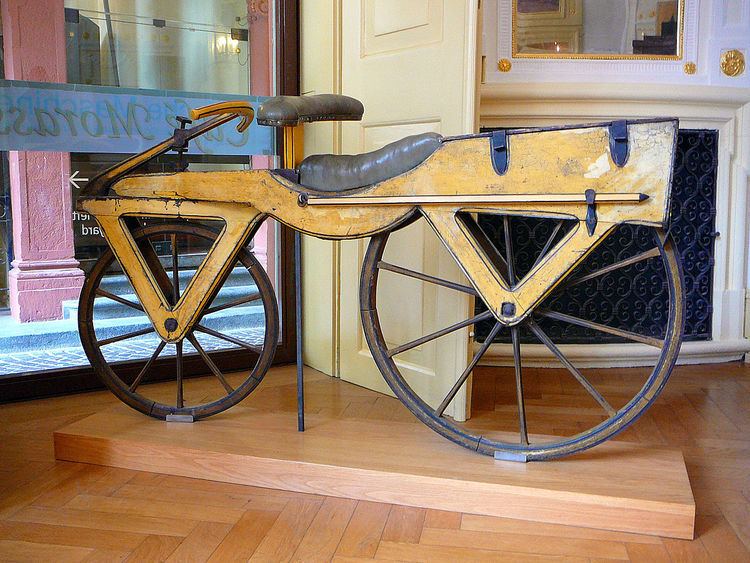 | ||
The dandy horse is a human-powered vehicle that, being the first means of transport to make use of the two-wheeler principle, is regarded as the forerunner of the bicycle. The dandy horse was invented by Baron Karl Drais in Mannheim, Germany, and patented in France in February 1818 (Badenian privilege in January 1818). It is also known as a Laufmaschine (Drais' own terminology, German for "running machine"), the official designation velocipede, or draisine (a term now used primarily for light auxiliary railcars regardless of their form of propulsion), and in its French form draisienne.
Contents
History
The dandy-horse was a two-wheeled vehicle, with both wheels in-line, propelled by the rider pushing along the ground with the feet as in regular walking or running. The front wheel and handlebar assembly was hinged to allow steering.
Several manufacturers in France and England made their own dandy-horses during its brief popularity in the summer of 1819—most notably Denis Johnson of London, who used an elegantly curved wooden frame which allowed the use of larger wheels. Riders preferred to operate their vehicles on the smooth sidewalks instead of the rough roads, but their interactions with pedestrians caused many municipalities worldwide to enact laws prohibiting their use. Later designs avoided the initial drawback of this device when it had to be made to measure, manufactured to conform with the height and the stride of its rider. An example is Nicéphore Niépce's 1818 model with an adjustable saddle for his 'velocipede' built by Lagrange.
However, in the 1860s in France, the vélocipède bicycle was created by attaching rotary cranks and pedals to the front-wheel hub of a dandy-horse.
Modern adaptation
The dandy horse has been adapted as a starter bicycle for children, and is variously called a balance bike or push bike.
In popular culture
Buster Keaton rides a dandy-horse in his 1923 film Our Hospitality, which is set in the 1830s. Keaton's technical crew were unable to obtain a vintage dandy horse, so they built one to match existing drawings and prints. Keaton later donated the machine to the Smithsonian Institution, which had lacked an authentic example.
George Arliss, as the title character of the 1929 film Disraeli, rides a dandy-horse through a London park until he collides with a woman pedestrian. This occurs in the opening scene of the film, set in the 1830s, when Disraeli was still a writer and a famous dandy.
A citizen is briefly seen riding a Dandy Horse through a forest trail in the 1997 film "Amistad" when the Slave Escapees first land on American soil.
A bi-annual magazine called "dandyhorse", based in Toronto, Canada, promotes art, fashion and cycling culture.
